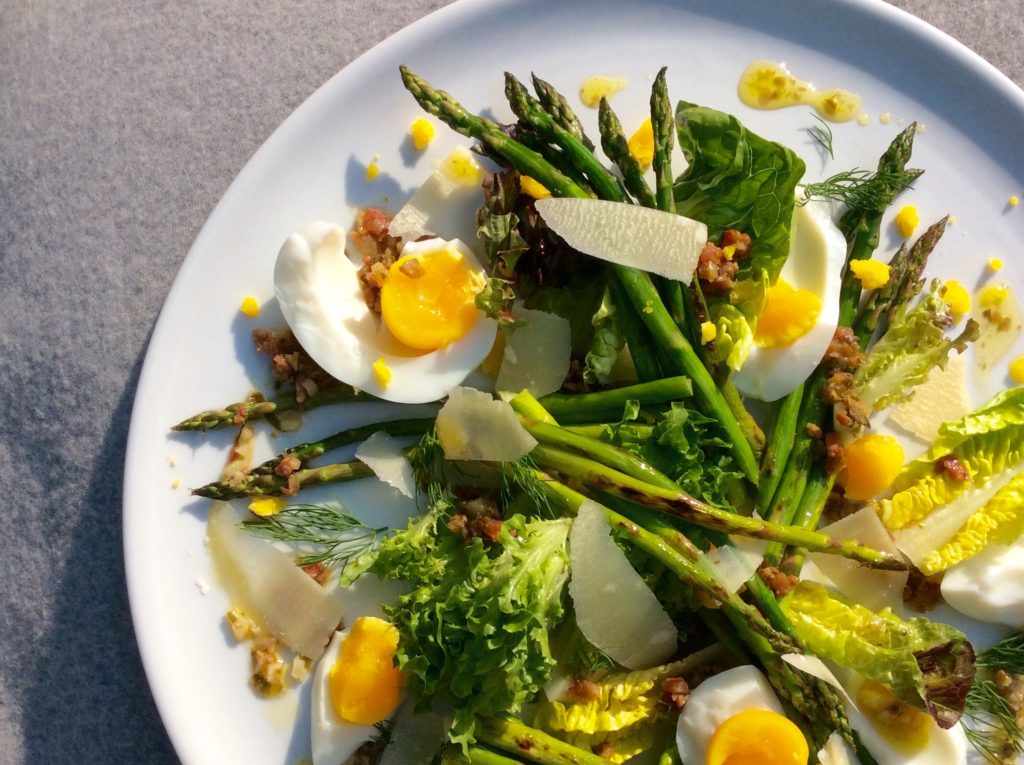
📣 PN Level 2 NOW OPEN: Get better client retention, results, and referrals. Save 44% + BONUS this week.

📣 PN Level 2 NOW OPEN: Get better client retention, results, and referrals. Save 44% + BONUS this week.

Asparagus is a bright green vegetable that is synonymous with spring. Asparagus spears are firm with leafy pointed tips. Packed with a slightly sweet, slightly nutty flavor, asparagus is also nutrient dense: it offers calcium, iron, magnesium, vitamin C, and loads of vitamin K. Asparagus is great roasted, in a sauté, or on the grill. Or try it shaved into a fresh summer salad.
Asparagus is a flowering perennial that comes into season during spring and early summer.
The plant produces tasty edible shoots which are picked and eaten before the buds open and the stems turn woody.
Asparagus has a sweet, slightly herbaceous, somewhat nutty flavor that pairs well with other garden-fresh veggies. It’s also a nice accompaniment to richly flavored foods like eggs, soft cheeses, and steak.
Asparagus grows in spears, which typically range between 5” – 8” long. Along each spear are fine scale-like leaves. At the top of each spear is a leafy, pointed tip, and at the bottom is a stout stem.
Green asparagus is most common, though white and purple varieties can also be found. Those varieties have subtle differences in taste and texture as well.
Stalks can range in thickness – some spears are thin and spindly while others are thick and stocky.
One cup of raw asparagus contains 27 calories, 3.0g of protein, 0.2g of fat, 5.2g of carbohydrates, 2.8g of fiber, and 2.5g of sugar.
Asparagus is a good source of calcium, iron, magnesium, and phosphorous. It’s also packed with vitamin K (one cup contains more than 100% of your daily vitamin K intake).
Other nutrients include folate, copper, vitamin B1, selenium, vitamin B2, vitamin C, and vitamin E.
Look for the freshest asparagus you can find.
When you purchase asparagus, you may find it sitting in a sheet pan of water – this is a good sign, as the water keeps it from drying out.
The base of the stalks (where they were cut) should look green and moist; if the base looks dry and yellow that’s a sign the asparagus has aged and is losing its freshness.
To maximize its flavor (and nutritional content), asparagus should be eaten as soon as possible.
If you can’t eat your asparagus on the same day you purchase it, wrap the base of the stems in a damp paper towel and store in a loose, open bag in the crisper of your refrigerator.
Once cooked, asparagus will keep in the fridge for 3-5 days.
To wash asparagus, rinse well under cool water. Rub the small leaves gently under the water to release any grime. If the asparagus is straight from the farm and still dirty, you can sit it in a bowl of cool water, give the water a swish, remove the asparagus, and rinse the dirt out of the bowl – then repeat for a few exchanges of water.
The base of asparagus stalks are usually tough and should be snapped off. You can either hold the stalk near its base and give them a quick snap, or cut the base off with a knife.
This multipurpose vegetable can be prepared in a multitude of ways: sautéed, roasted, grilled, or boiled.
It can also be eaten raw; try shaving it with a vegetable peeler and adding it to a salad, or blanching it quickly in boiling water (1 – 2 minutes), rinsing it in cold water, and enjoying it as part of a raw veggie platter.
The trick to enjoying asparagus is to avoid overcooking it: spears should be firm but tender (not floppy or mushy).

This quick and savoury salad is brimming with nutrition and makes a perfect lunch or quick weeknight meal. You can also serve it as a light appetizer.
Prep Time: 10 minutes Cook Time: 15 minutes Yield: 4 appetizers
Vinaigrette directions:
In a medium sized pan, add the pancetta and render over medium heat for 4 minutes. Add the anchovies, garlic, and capers. Cook for another 2 minutes. Scrape out the pancetta mixture into a small bowl. Add the olive oil and vinegar to the pancetta and stir to combine.
Salad directions:
Place the eggs in a small sauce pot. Add cold water until eggs are covered by about 1 inch. Bring to a boil over high heat. Let the water boil for 4 minutes. Once the 4 minutes is up, pour out the boiling water and replace with ice cold water to stop the cooking. Set aside.
Place the asparagus in a single layer in a medium sized pan over high heat. Cook, shaking the pan every 30 seconds or so, until the asparagus turns bright green. Remove from heat and set aside.
Peel and cut the eggs.
In a large mixing bowl, combine the baby lettuce, asparagus, salt, and vinegar and toss gently.
Assembly:
Add half of the vinaigrette to the mixing bowl and mix. Arrange on a platter or salad bowl and garnish with eggs, dill fronds, and parmesan. Serve immediately.
Enjoy!
Precision Nutrition’s Encyclopedia of Food expands every single month as we highlight new foods and showcase beautiful food photography. If you’d like to stay up to date, simply click this link. From there, we’ll send you a FREE copy of our recipe book. We’ll also let you know when new and delicious foods are added to the site.
Asparagus is a bright green vegetable that is synonymous with spring. Asparagus spears are firm with leafy pointed tips. Packed with a slightly sweet, slightly nutty flavor, asparagus is also nutrient dense: it offers calcium, iron, magnesium, vitamin C, and loads of vitamin K. Asparagus is great roasted, in a sauté, or on the grill. Or try it shaved into a fresh summer salad.